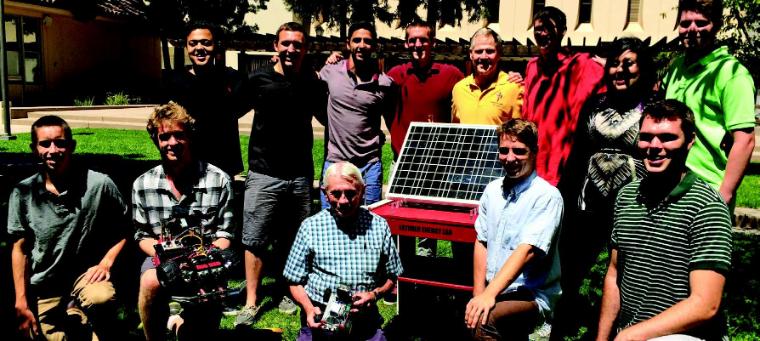
More Power to These Summer Scholars
Heidi Williams
For two months this past summer, one graduate and 10 undergraduate engineering students were paid by the School of Engineering’s Latimer Energy Lab to design and build a prototype of a solar-powered, autonomous vehicle and wireless charging station. "We are in the midst of a revolution that will affect our lives dramatically," said Tim Healy, lab director and professor of electrical engineering. "Electric vehicles will dominate transportation, and energy storage will change everything. If our students have a leg up on these technologies, career opportunities will be wide open."
Knowing that those in this groundbreaking field need a thorough understanding of how multiple engineering disciplines work together, Healy included the issues of solar power collection, controls systems, energy storage, wireless charging, and autonomous vehicles into the challenge. He provided minimal constraints or guidelines on how to tackle the challenge, but met with the team regularly to check their status and offer assistance. "My role was not to mentor, but to enable. They really were very independent, and that was fine with me," he said. The students—Fred Feyzi, Stan Whitcomb (computer science and engineering), Brad Ydens (electrical/computer science and engineering), Alejandra Huitron, Danny Mendoza, Peter Roguski (electrical engineering), Drew Azevedo, Ryan Greenough, Mike Rudolf, Peter Stephens, and David Swan (mechanical engineering)—quickly got to work devising a plan of attack.
"We split up into teams: control, electronics/docking station, platform, and sensors. The first weeks were research overkill—reading things we may or may not need, but getting background. We didn't know where we were supposed to go or what parts we would need; it took a month for us to figure out which battery would work," said one of the scholars. But soon the platform team had the vehicle built using purchased items and components they’d created in the School of Engineering’s Maker Lab; the sensors team had ruled out using parallax range finders or ultrasonic sensors in lieu of a photo resistor sensor and four ping sensors; and the control team set to work on GPS communication and efficient operation of the autonomous car. Meanwhile, the docking station/electronics group was figuring out appropriate battery sizes for the car and charging station and how to manage the power loss inherent in wireless systems.
Concerned that the team take a break from the project occasionally—it was summer, after all—Healy established an unconventional rule: every Friday afternoon the team (still on the payroll) had to get out of the lab and go out and do something. Though it wasn’t stipulated that they do something together, they did. Hiking, trying new food at a Mongolian restaurant, and visiting the Intel Museum together built camaraderie. "Our Fridays off built team chemistry," one student said. "It was awkward at first but we became very close." This bond helped the team persist through difficulties.
"There was a lot of push/pull with the project; it seemed like we would get one thing to work and another would go the other direction. Dr. Healy helped by reaching out to engineers from National Instruments, Linear Technology Corporation, and Texas Instruments. They came in and offered suggestions, gave us boards to play around with, and showed us how to make the wireless charging more efficient. The guys at TI had worked on the Google car, so it was really cool to learn from them."
At the end of eight weeks, the team showed off their solar-powered autonomous car and wireless charging station to Mike Wagner ’69 (it was his and wife Jolon's generous donation that led to the establishment of the Latimer Energy Scholars Program in 2011), sharing their enthusiasm for the experience and for the future of autonomous vehicles. "Right now, it's just barely an idea, but it could get very big very fast," said one team member.